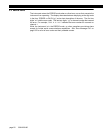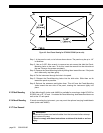
SC Series Instruction Manual page 21
Operating Modes3
To clear the peak and valley values of all channels simultaneously, use the Sys-
tem connector’s Function Input #2 pin. See “System Connector” on page 35 for
details.
To clear the peak and valley values of a single channel regardless of which chan-
nel is being monitored by the display, use the channel’s AUX1 or AUX2 control
pins on its connector. See the particular chapter regarding that channel for
details.
3.3.4 [CHANNEL] button
If the configuration of the instrument contains more than one channel, the left
most characters of the display indicates which channel the display is monitoring.
Pressing and releasing the [CHANNEL] button will cause the next channel to be
displayed.
On instruments with a dual-line display, the [CHANNEL] button cannot be used to
change which channel the lower line is monitoring. That is selected with the “
DIS-
PLAY MENU
->
LOWER CHANNEL
” menu item.
Shunt Calibration Check
If the [CHANNEL] button is held down for more than 3 seconds, the present chan-
nel’s shunt calibration value (if the channel has shunt calibration available) will be
displayed.
3.3.5 [TARE] button
To reset the channel’s display to zero, press the [TARE] button while in RUN
mode. To restore the tare value, press the [TARE] button again. The “Tare” indica-
tor will illuminate when tare is on.
To tare all channels simultaneously, use the System connector’s Function 1 Input
pin. See “System Connector” on page 35.
To tare a single channel regardless of which channel is being monitored by the
display, use the channel’s AUX1 or AUX2 control pins on its connector. See the
particular chapter regarding that channel for details.
3.3.6 Indicator Lights
Models SC1000, SC2000, SC2001
A “"“ symbol on the right side of a channel’s display indicates tare is off for that
channel; a “
Ë“ symbol indicates tare is on.
If the lower line of the display is configured with the “
DISPLAY MENU
->
LOWER MODE
”
menu item as “
LIMIT 01-04
”, then the lower line will monitor the status of Limits 1, 2,
3 and 4. A “
"“ symbol indicates a limit is deactivated; a “Ë“ symbol indicates a limit
is activated. For example:
L1
"
L2
"
L3
Ë
L4
Ë
indicates that Limit 1 and Limit 2 are deactivated and Limit 3 and Limit 4 are acti-
vated. Since the SC1000 is not equipped with limits, the lower line of the display
will be blank. See “LOWER MODE Menu Item” on page 51.
These indicators may be overridden by the operation of a Mathematics channel in
special applications.
Model SC3004
Front panel lights “L-1”, “L-2”, “L-3”, and “L-4”, monitor the status of Limits 1, 2, 3,
and 4. Model SC3004 instruments also include front panel lights labeled “L-5”, “L-
6”, “L-7” and “L-8” which monitor the status of optional Limits 5, 6, 7, and 8.
The function of the front panel lights may be overridden by the operation of a
Mathematics channel in special applications.


















